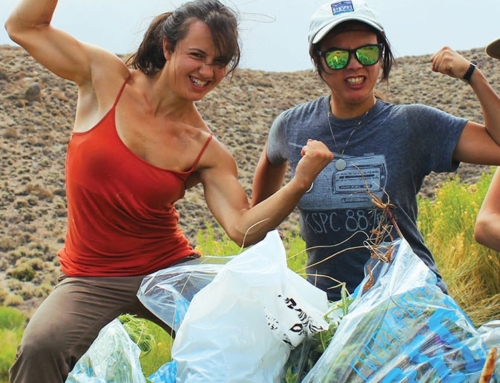written by Jessie O’Dell, ESLT Intern
As the summer unfolds to reveal the beauty of the Sierra, the opportunity to explore the lands ESLT is working to preserve always reawakens my admiration of the world in which we live. Having grown up in Swall Meadows for all of my 17 years, I have spent much of my life scrambling around the trails of the Eastern Sierra, always searching for new ways to enjoy the beautiful mountains. I have always felt a connection to the natural world around us as well as a duty to protect it. Because of this, the opportunity to take a summer internship at Eastern Sierra Land Trust has truly been a dream come true! Not only has it been great to enjoy summer in the Eastern Sierra, but it has also been an exciting experience to learn more about the nuts and bolts of conservation. It is interesting to learn how ESLT partners with private landowners to preserve the natural scenery, wildlife habitat, and agricultural values of their lands.
The Montgomery Creek Ranch conservation easement epitomizes the work of the land trust. Over 130 years old, Montgomery Creek Ranch is a working ranch nestled on rich soil below the White Mountains. The ranch grows organic alfalfa while using other parts of the land for cattle grazing. An important part of the conservation process is the yearly monitoring of each easement to encourage communication with the landowners as well as to ensure that the agreement set out between the land trust and the landowners is being upheld.
I was lucky enough to be able to accompany Aaron, the Lands Program Coordinator, on the annual monitoring of the ranch. Despite high temperatures, Aaron and I jumped into the truck and headed out to Hammil Valley. Even at the height of summer, as we made our way onto the ranch we were met by lush fields of alfalfa. Once at the ranch, we used GPS to find the photo-points from which pictures were taken when the easement was first recorded to chart the changes and progress of the easement. At each point, we compared the previous pictures to the condition of the land this summer and checked to make sure that the land hadn’t been developed or altered outside of the easement requirements. At each photo-point we were happy to see that the lands had stayed much the same, apart from some improvements. We were also pleasantly surprised at the amount of growth that had occurred since last year as a result of the high precipitation this season. Overall, the visit was a great experience. Not only was I able to learn more about how each easement is preserved, but I also learned much more about the unique characteristics of the ranch as Aaron shared his wealth of knowledge about the history of the ranch as well as the native species that inhabit it. Monitoring easements each year is a crucial part of ensuring that our rural Eastern Sierra lands continue to be beautiful farmland and wildlife habitat.








